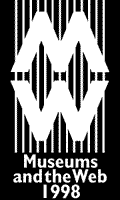 |
|
Archives & Museum Informatics info @archimuse.com |

 |
Time-Travels in Virtual Online Landscapes: New Presentation Possibilities with Online Virtual RealityAskan Striepe & Christian Quintus, Fraunhofer-Institute for Production Systems and Design Technology (FhG-IPK); Ingo Braun and Anja Kutzner, Kulturbox GmbH; Andreas Knoche and Leonie Schäfer, Technical University of Berlin; and Birgit Böhme and Uta Simmons, Centre of Berlin Studies, Germany Main
Session: Interfaces
This paper discusses the opportunities offered by virtual online landscapes
to the design and organization of historical exhibitions.The authors
report about their experiences with the development of a time variable
VR-platform for museums archives and libraries. For this purpose a historical
quarter of the city of Berlin has been reconstructed in three different
time levels (1855, 1928, 1992). In addition this platform will serve
as an environment for the presentation of exhibitions about various
subjects. Exhibits in digitized form (text, pictures sound, film clips
and three-dimensional objects) will be included online from the databases
of the associated museums and archives.
|
![]()
